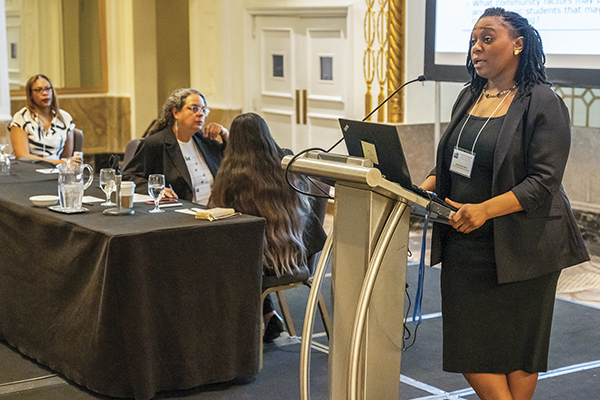Productive Partners: Researchers and Education Leaders
May 01, 2023
Research-practice collaborators leverage the expertise of higher education to help school districts better serve all students
.jpg?sfvrsn=ad0d4768_3)
When Beth Polito began her tenure as superintendent in Woodside, Calif., home to a small, well-resourced school district in the San Francisco Bay area, she struggled to find resources to support instruction of multilingual learners.
Although the school district had only 500 students spanning grades K-8 and had substantial per-pupil funding, there were many years when the data in Woodside’s accountability report card indicated the schools were not serving multilingual students well in comparison to other student populations.
Polito knew there was no quick fix, no magic curriculum the district could adopt that would help teachers work with the two or three multilingual learners in their classrooms who struggled with English proficiency. She knew a radical change was necessary to overcome the status quo practices, such as pulling out students for specialized instruction in what Polito calls the “teacher or teacher’s aide-in-the-closet” approach.
This Content is Exclusive to Members
AASA Member? Login to Access the Full Resource
Not a Member? Join Now | Learn More About Membership
Using Research to Shift Course in a Pandemic
BY AKISHA OSEI SARFO

When I served recently as chief performance officer in North Carolina’s Guilford County Schools, the strategic use of data and research played a significant role in how the district responded to the COVID-19 pandemic. Research supported the district’s ability to pivot instruction and operations to address the escalating needs of students and their families.
Most importantly, the district used early-released research that predicted the impact of the pandemic on learning, strategically focusing on designing and implementing math programs for students most likely at risk for experiencing the most unfinished learning.
The district partnered with local universities to provide direct tutoring support and extended learning opportunities for these students, and now it is seeing a faster recovery in math performance than the state, across grades 3-8 and among all student groups. This is evidence that the use of educational research is critical to sound decision making in schools.
Based on my district research experiences and my current research work with the nation’s 78 largest urban school districts, I’ve identified three strategies that enhance the use of research in school district operations, program development and decision making.
Research-Driven Leadership
School district leaders are the drivers of embedded research use. A main factor contributing to the success in Guilford and other large-city districts during COVID-19 was leadership’s understanding of the value of quality research in guiding decision-making processes and operations.
District research offices are a key aspect of district leadership. They generate, elevate and facilitate the use of research across schools and districts. Districts that make intentional investments in highly qualified and properly staffed research offices are likely to benefit from improved student outcomes. Chicago, Dallas, Miami-Dade and Los Angeles have leveraged the use of high-quality research across their districts through consistent investments in their research departments.
Equity-Focused Data
While it’s important to advance the production and use of research to improve district operations and support districtwide decisions, it’s simply not enough. District research practices must be equity-focused, paying specific attention to studies of marginalized communities and understanding the influence that historic and systemic barriers continue to have on student achievement and experiences.
In Guilford, we used academic research as well as interviews of students at risk of failure and their parents to modify our practices. This strategy allowed the district to identify barriers to learning that students experienced throughout COVID-19 and their needs for support, which led to investments in community liaisons to improve school-community communications.
Increased Capacity
To make effective use of research, school districts must have the capacity in the form of dedicated staffing. That might mean looking at different paths for increasing research use and production.
One way districts can address research capacity limitations is through external collaboration, working with researchers at universities or research firms through research-practice partnerships or by hiring graduate student interns or research fellows.
Research-practice partnerships typically are long-term relationships between research and practice institutions that co-design studies on relevant challenges in education. Well-established research-practice partnerships include the Research Alliance for New York City Schools, UChicago Consortium on School Research and the Houston Education Research Consortium.
Each demonstrates evidence of the effective development and use of co-designed research, conducting studies on postsecondary readiness, student mobility, student engagement and English learners, among many other studies driving district improvements.
Akisha Osei Sarfo is director of research with the Council of the Great City Schools in Washington, D.C. @akishasarfo
Additional Resources
Paula Arce-Trigatti and Laura Wentworth suggest these informational resources to learn more about research-practice partnerships and to connect with people who can help you form collaborative partnerships with researchers.
“Assessing Research-Practice Partnerships: Five Dimensions of Effectiveness,” a publication from The William T. Grant Foundation, provides a framework for developing and assessing effective research-practice partnerships.
The Council of the Great City Schools offers a number of learning communities across district roles where leaders can discuss experiences working in research-practice partnerships.
The National Network of Education Research-Partnerships Knowledge Clearinghouse, based at the Kinder Institute for Urban Research at Rice University, offers a curated collection of RPP-related resources from across the internet.
Advertisement
Advertisement
Advertisement
Advertisement
